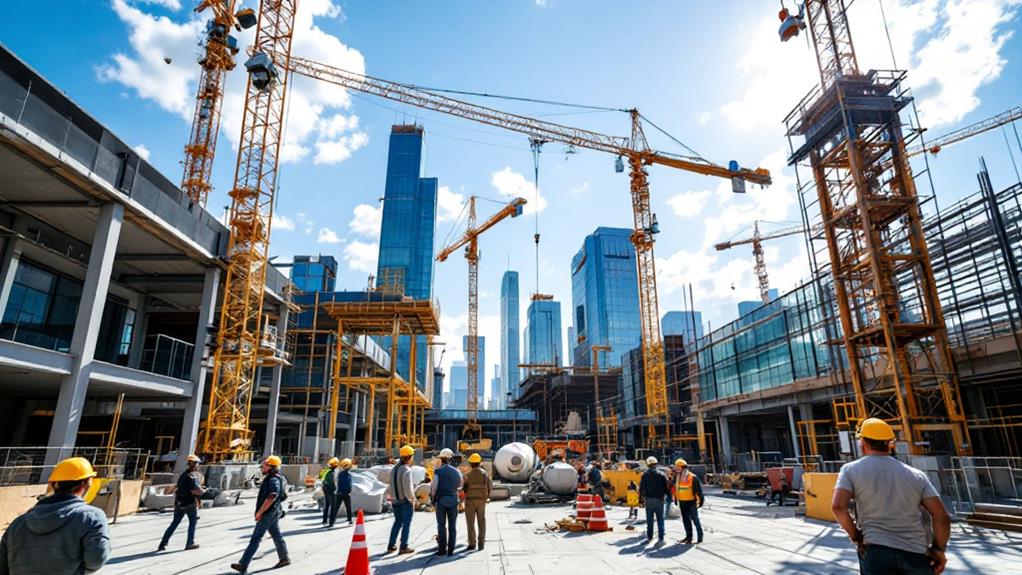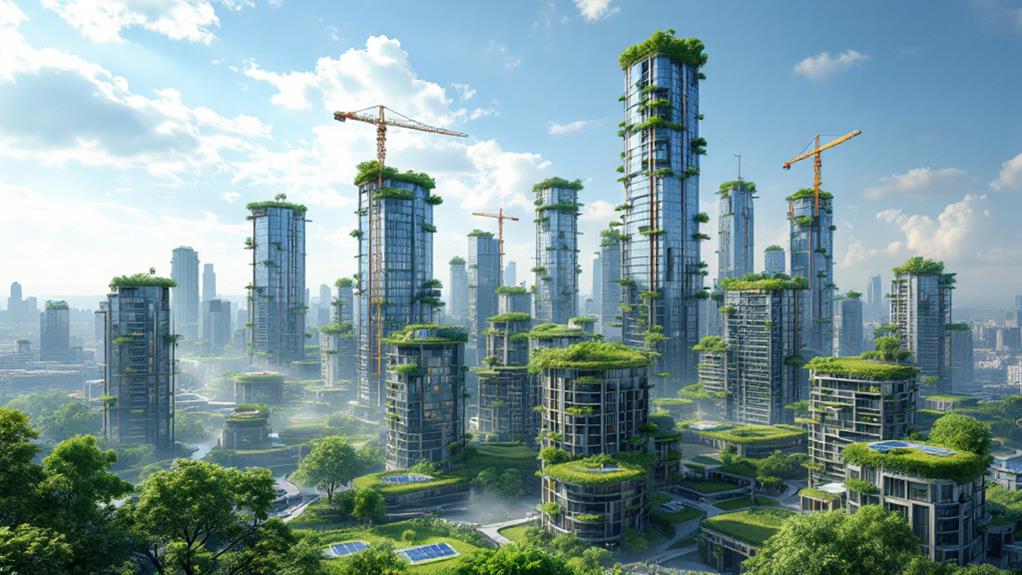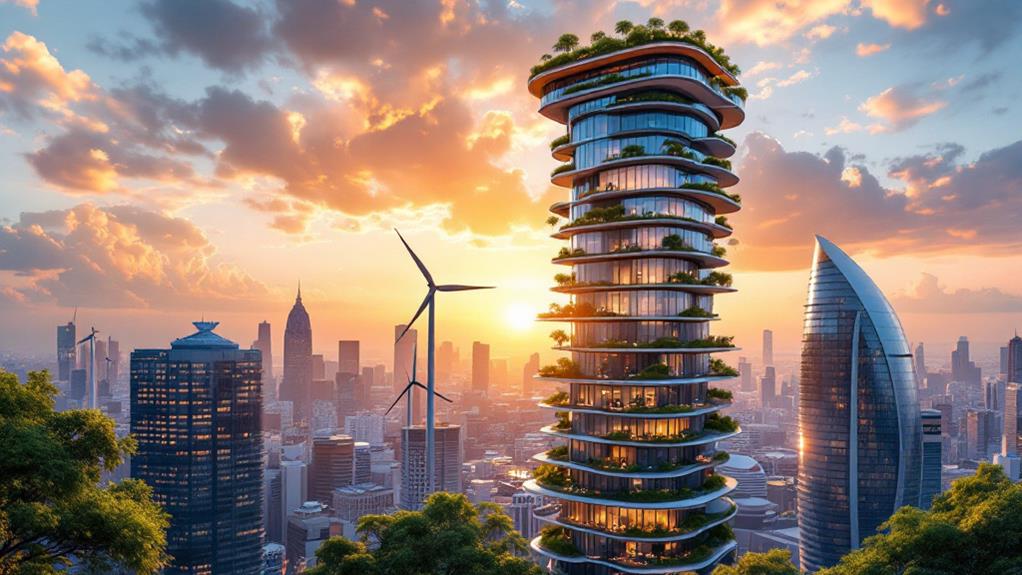How the World’s Largest Buildings Are Built: Materials and Techniques

When exploring how the world's largest buildings are built, you'll find steel and reinforced concrete as key materials, replacing older masonry for lighter, taller structures. Engineers use tubular and buttressed core designs to optimize space and resist wind forces. Advances like high-speed elevators guarantee efficient vertical transportation. Structural innovations, such as tube-in-tube, bundled tube, and outriggers, greatly improve stability and construction efficiency. Emerging materials like carbon fiber promise even stronger skyscrapers. Engineers also factor in environmental challenges like wind and seismic activity when designing these giants. There's so much more to uncover about these engineering marvels.
Evolution of Skyscraper Materials
The evolution of skyscraper materials transformed the architectural landscape, allowing buildings to soar to new heights. You no longer need thick masonry walls, which once restricted the height and interior space of tall buildings. Instead, the introduction of steel and reinforced concrete permits slender and efficient structures. This shift began in the early 20th century, when steel skeleton frameworks replaced heavy masonry, drastically reducing the weight and bulk of building materials.
With the advent of industrial steel, architects and engineers could reimagine how tall buildings interacted with their environments. Fazlur Rahman Khan's tubular design concept became a game-changer. This groundbreaking approach utilizes exterior steel frames to absorb and transfer wind forces efficiently, maximizing interior space. The Burj Khalifa, the tallest building in the world, exemplifies state-of-the-art materials and techniques. It uses a buttressed core design, strategically placing load-bearing elements to improve stability against high winds while supporting its numerous floors.
Steel and reinforced concrete remain at the forefront of skyscraper construction, allowing architects to push the boundaries of height and design. By using these materials strategically, you help guarantee that our cities can continue to grow vertically, reaching for the sky.
Advancements in Structural Engineering
In recent years, remarkable advancements in structural engineering have transformed how skyscrapers are designed and constructed. You're now seeing tall structures that push the boundaries of what was once thought possible. The shift from load-bearing masonry to steel skeleton frameworks in the early 20th century set the stage for this evolution, allowing skyscrapers to soar to unprecedented heights. Fazlur Khan's tubular design concept was groundbreaking, utilizing exterior steel frames to absorb and transfer wind forces effectively. This eliminated the need for internal columns, greatly maximizing usable space.
Modern innovations like the buttressed core design, as seen in the Burj Khalifa, strategically position load-bearing elements to counteract wind forces, enabling the creation of ultra-tall buildings. The tube-in-tube and bundled tube designs have further advanced skyscraper construction. These composite structures resist lateral forces efficiently, offering improved stability and allowing for greater heights. Moreover, advanced techniques such as outrigger systems and new formwork technologies have enhanced the speed and efficiency of concrete construction. As you observe these advancements, it's clear that structural engineering continues to reshape the skylines of cities around the world, making even taller skyscrapers a reality.
Overcoming Environmental Challenges

As skyscrapers reach new heights thanks to advancements in structural engineering, they face increasing environmental challenges that demand creative solutions. One of the biggest challenges is wind forces, which can affect a building's stability, especially those towering over 10 stories. To combat this, architects use buttressed core designs, like those in the Burj Khalifa, strategically positioning load-bearing areas to counteract wind pressure. This design reinforces the building's core, helping it withstand strong gusts.
Tubular design concepts, introduced by Fazlur Rahman Khan, revolutionize skyscraper stability. These designs allow the building to absorb and transfer wind forces without relying heavily on internal columns, thereby maximizing interior space. By using groundbreaking structural systems like outriggers and bundled tube designs, architects improve a building's stiffness and stability, allowing it to resist lateral loads from wind effectively.
Environmental factors also play a significant role in skyscraper design. Geological assessments guide the choice of materials and structural systems, guaranteeing the building can adapt to local conditions and potential seismic activity. By addressing these challenges with creativity and precision, you can guarantee that skyscrapers remain safe and resilient, even in the face of nature's forces.
Future Design Innovations
Imagine skyscrapers of the future that redefine what's possible in architecture. These towering giants will adopt advanced materials and cutting-edge techniques to push the boundaries of design and functionality. Picture a skyline where carbon fiber and smart glass transform high-rise buildings into marvels of energy efficiency and performance. The drive for sustainability will lead architects to integrate green building practices, renewable energy sources, and adaptive reuse of structures.
Look forward to these exciting advancements:
- Advanced Materials: Expect lighter and stronger skyscrapers using carbon fiber and smart glass.
- Modular Construction: Streamlining construction processes with prefabricated parts, speeding up timelines.
- Energy Efficiency: Smart systems optimizing energy use, reducing emissions, and cutting costs.
- Creative Structural Solutions: Designs like interconnected legs for wind resistance, as seen in Tokyo's Sky Mile Tower.
- Sustainability: Adopting green technologies and renewable energy to reduce environmental impact.
In this bold new age of construction, projects like the Jeddah Tower are setting the stage for unprecedented architectural achievements. As designers focus on creative structural solutions, the skyscrapers of tomorrow will not only dazzle with their height but also contribute positively to the environment.
Enhancing User Experience in Tall Buildings

While future skyscrapers promise groundbreaking designs and sustainability, they also focus on the user's experience within these architectural wonders. You're whisked up to your desired floor in seconds, thanks to fast vertical transportation systems, which use high-speed elevators to eliminate long wait times. This efficiency makes your passage through the building seamless and stress-free.
Safety is paramount in these towering structures. Advanced fire protection technologies, like state-of-the-art sprinkler systems and smoke evacuation strategies, guarantee you have reliable emergency responses at your disposal. You can feel secure knowing these measures are in place to protect you and others.
Comfort is key, and climate control systems play an essential role in maintaining ideal temperature and air quality. No matter the weather outside, these systems keep your environment pleasant and comfortable. Coupled with noise reduction technologies, which use sound-insulating materials, your space remains quiet and peaceful, free from disruptive noise.
Smart building systems integrate cutting-edge technology to manage energy efficiently. They allow real-time monitoring and control of operations, guaranteeing energy efficiency and reduced operational costs. This not only benefits the environment but also improves your comprehensive experience in these impressive structures.



